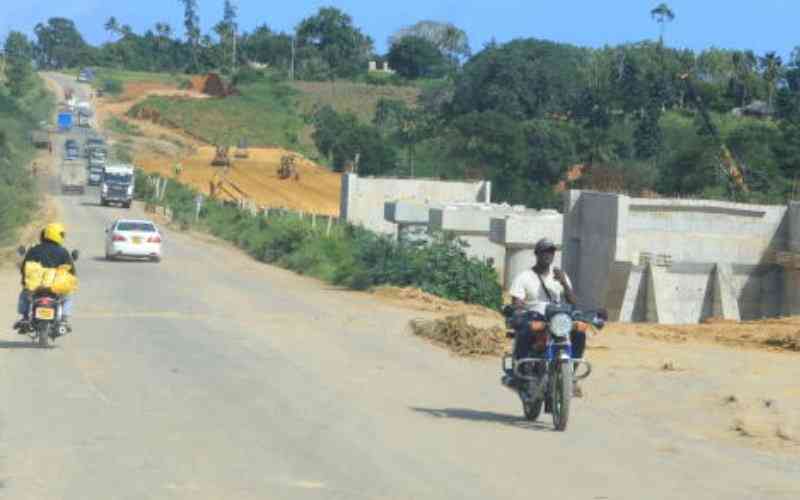Kenyans will go into 2022 elections with a different skyline in the city as the 27km Nairobi Expressway is expected to have been completed.
The Sh62 billion project, which was started late last year, could revolutionalise transport in Nairobi and ease traffic jams on Mombasa Road.
Transport Cabinet Secretary James Macharia said they had asked the contractor to speed up the works. “The project started in June, but there was a bit of delay because of Covid-19 but we have asked the contractor to fast track the construction to take between 18 months to two years so that we can have the road by June 2022,” said Macharia.
He said the traffic jam on Mombasa road cost the country millions of shillings in fuel and wasted time and the expressway ease that. “We are now negotiating with the contractor to ensure that once completed the tolling cost will be affordable for the motorist,” he said.
The project is being implemented at a time the Nairobi Metropolitan Service (NMS) is reshaping Nairobi, once known as The Green City in the Sun.
According to Peter Mundinia, the Kenya National Highways Authority (Kenha) Director-General, upon completion, Kenya’s first road to be tolled under a public-private participation arrangement will see motorists take 20 minutes to drive across the city from Mlolongo to Rironi near Limuru, through Westlands.
In a normal flow of traffic currently, it takes two to three hours to cover the same stretch.
Mundinia said his agency, as the implementing partner, had overseen all the feasibility studies, traffic origin and destinations survey, geological investigations and the submission of Privately Initiated Investment Proposal (PIIP) between Kenha and China Road and Bridge Corporation (CRBC) – the contractor.
He said the expressway will play an instrumental role in the journey to attain the aspirations of the Kenya Vision 2030 — to make Kenya a globally competitive and prosperous country with a high quality of life by 2030.
The project is expected to considerably ease traffic flow on the Mlolongo-James Gichuru A8 section and is expected to eventually reduce travel time through Nairobi.
Legal framework
The Nairobi Expressway is a four-lane dual carriageway designed to run along the central reserve of the A8 road starting from Mlolongo, all the way to the James Gichuru junction.
President Uhuru Kenyatta is expected to assent to the Tolling Bill 2019 this week, in effect giving the contractor the legal framework to use in charging for the road’s use.
“We passed the Bill and it could be assented to by the president anytime this week. This will give the contractor the impetus to start the construction,” said David Pkosing, the National Assembly Transport Committee chairman.
Pkosing said the Bill was captured in the Finance Act 2020 that President Kenyatta signed.
Stay informed. Subscribe to our newsletter
According to the detailed plan, the Development of Nairobi Expressway Project, the planned aesthetics in the road’s construction will give Nairobi a facelift.
A statement from China noted that the functions of the current interchanges at Cabanans, Ole Sereni and Museum Hill will remain, and the expressway will make them more convenient and smooth. The footbridges along the alignment will be retained or rebuilt.
In total, the road will have 11 interchanges that will allow easy exit and entry at major points. They will be at Mlolongo SGR terminus, Eastern and Southern bypasses, Capital Centre, Haille Selasie Avenue, Museum Hill, the Mall Westlands and James Gichuru Road junction.
The statement said the expressway will be a whole corridor and will have the component of the Bus Rapid Transport (BRT), which will be incorporated later, room for utility services like electricity, water, sewerage and ISPs.
Buildings demolished
Originally set to commence in 2011, the expressway was halted after the Word Bank declined to release funds, citing a hitch with Strabag International in the list of contractors before CRBC took over.
The completed feasibility studies and road design plans have identified 34 acres of public and private land to be acquired for the road and will see a number of big buildings demolished. Land and building compensations will cost the government over Sh4.1 billion.
In the plan, motorists on the expressway will have a number of toll stations where they will be required to pay.
Some of the properties to be affected by the construction include Next Gen Mall, Khalsa Primary School, parts of the Railways Club and Boulevard Hotel.
 The Standard Group Plc is a
multi-media organization with investments in media platforms spanning newspaper
print operations, television, radio broadcasting, digital and online services. The
Standard Group is recognized as a leading multi-media house in Kenya with a key
influence in matters of national and international interest.
The Standard Group Plc is a
multi-media organization with investments in media platforms spanning newspaper
print operations, television, radio broadcasting, digital and online services. The
Standard Group is recognized as a leading multi-media house in Kenya with a key
influence in matters of national and international interest.
 The Standard Group Plc is a
multi-media organization with investments in media platforms spanning newspaper
print operations, television, radio broadcasting, digital and online services. The
Standard Group is recognized as a leading multi-media house in Kenya with a key
influence in matters of national and international interest.
The Standard Group Plc is a
multi-media organization with investments in media platforms spanning newspaper
print operations, television, radio broadcasting, digital and online services. The
Standard Group is recognized as a leading multi-media house in Kenya with a key
influence in matters of national and international interest.





